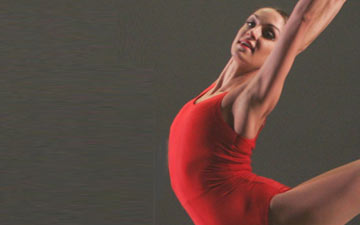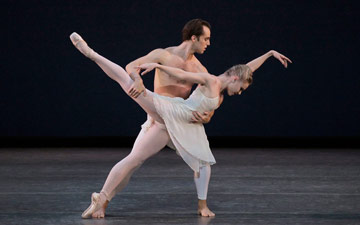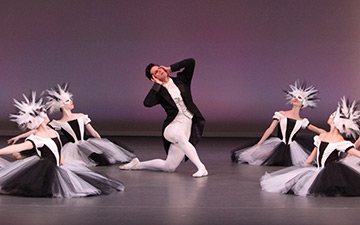
© Paul Kolnik. (Click image for larger version)
New York City Ballet
Who Cares?, Ivesiana, Tarantella, Stars and Stripes
New York, David H. Koch Theater
30 April 2013
www.nycballet.com
The Ghosts of Spring at NYCB
It’s always a thrill when a promotion opens new vistas for a dancer one has been noticing for some time, quietly glowing in the corps or breathing extra life into smaller featured roles. And then it is heartening to see that dancer rise to the occasion, not with avidity, but with a kind of unleashing of energy and of the poetic imagination. So it was last night with Ashley Laracey at the opening-night performance of New York City Ballet, in Balanchine’s Ivesiana (1954). For those who watch the company closely, it was a confirmation of qualities one suspected were lying there, waiting to be put fully to use. Better yet, it was as if she had nothing to prove. For the casual observer, the effect was perhaps even more magical: Laracey simply brought the choreography to life.

© Troy Schumacher. (Click image for larger version)
Laracey, who was bumped up from corps-member to soloist at the end of last season (along with seven others), was débuting in Ivesiana, along with four of her colleagues. The rest of the all-Balanchine program, which marked the thirtieth anniversary of Balanchine’s death, consisted of Who Cares? (1970), Tarantella (1964), and Stars and Stripes (1958). Following the recent logic that every season must have a theme, the company has christened the next few weeks the “American Music Festival,” with ballets set to music by Duke Ellington, Richard Rodgers, Nico Muhly, John Adams, and Charles Wuorinen, among others. Last night’s fare included helpings of Gershwin, Charles Ives, Louis Moreau Gottschalk and John Philip Sousa. Both the Gershwin and the Sousa were performed in arrangements by Hershy Kay. With the exception of Ivesiana, the mood was relentlessly upbeat, which is not a bad way to start the season.
But stuck in the middle of all this brightness was Ivesiana, like a ghost at a birthday party. It is a most unsettling ballet. Made in 1954 (the same year as Western Symphony, of all things) for a cast of dancers that included Janet Reed, Allegra Kent, Tanaquil LeClercq, Francisco Moncion, and Todd Bolender, it is one of Balnachine’s simplest, and most unnerving, compositions. Four ideas, four sections, not many steps, and no pointe-work – except in the crazed third chapter, “In the Inn,” which is crammed to the gills with steps and performed on pointe. Each movement is named after the musical work that inspired it; the entire thing is steeped in an atsmophere of suffocating irresolution, of irratonal occurrences and otherworldliness. Ives’s pieces have names like “Central Park in the Dark” and “The Unanswered Question,” and present themselves as smears of sound, misty vapors of notes that never quite congeal into a tonality or rhythmic structure. Balanchine’s imagistic tone-poems are the same: the master-craftsman forgoes his usual crisp vocabulary and instead crafts a series of ghostly images – whether nightmares or fairy tales I’m not sure – that send shivers down the spine.

© Paul Kolnik. (Click image for larger version)
In the first, “Central Park,” a young woman in white (Laracey), with hair loose, finds her way, blindly, through a teeming sea of bodies representing trees (one assumes). They sway gently, bathed in semi-darkness, their bending torsos and fluid limbs bringing to mind seaweed or coral, or perhaps the spirits of the dead. There is more than a hint of Orpheus here. Laracey’s hands feel the air; she’s lost, with no way out. A man (Zachary Catazaro, ardent and handsome if perhaps still a bit timid) appears. He pulls her, through clumps that dissolve and reappear elsewhere, like amoebas, or link arms like mossy vines (or jump-ropes). The woman struggles and collapses, the man runs off. Then, after a moment, she rises and walks away, as if nothing has happened, still reaching into the darkness with unseeing eyes, a sleepwalker lost in the forest. Perhaps it’s all a dream, or some kind of Freudian vision – her “Embattled Garden.” Throughout, Laracey’s delicacy, her quietly intense inner gaze, gives this opening section a pulsing, and yet utterly natural, life. (The fact that her partner-in-life, company-member Troy Schumacher, is a budding choreographer who has highlighted these very qualities in several short pieces of his own has surely encouraged her blossoming, after ten years in the corps.)

© Erin Baiano. (Click image for larger version)
Janie Taylor, the only dancer in the cast who had already performed a section of Ivesiana (a portion was excerpted in 2008, but the whole piece has not been seen since 2004), was equally at home in the ghostly imagery of “The Unanswered Question.” A female figure – angel? ghost? – is held aloft by four men cloaked in darkness, occasionally swooping down and then away from a man, played by the young Anthony Huxley. His entire body is racked with longing for her, but, as with the fairy in Baiser de la Fée or the sylph in La Sylphide, it’s clear that close proximity to this apparition promises only destruction. In a haunting and erotic image she passes over his prone body, just inches from his skin, close enough for him to feel her presence. Her feet never touch the ground. For one strange moment, she gives herself to him, folded into a strange, awkward package, which he holds to his chest, almost like a fetus. Then she flies off, carried on the men’s shoulders like the ballerina in Serenade. “In the Inn” is a completely unhinged Charleston (danced here, with almost deranged abandon, by Sara Mearns and the affable Amar Ramasar, looking slightly bemused). The contrast in tone is jarring, to put it mildly, and one half expects the passage, all vigorous taps of the pointe shoe and hip shimmies, to end with the woman planting a knife in the middle of the man’s chest, like a scene out of The Shining. (Instead, the two partners simply walk offstage, waving to each other as if to say, “forget it.”) Then comes the closing piece, in which the ensemble drifts across the stage, shuffling on its knees – a fact that barely registers in the creuscular lighting – like lost souls. That’s all they do. The whole thing leaves you shivering. Perhaps because of its very spareness – the ballet’s only additional element is the expressive lighting – it hasn’t aged at all. It’s a fairytale ballet taken out of context, out of time.
The evening had opened with the frisky Who Cares, set to Gershwin tunes, tritely orchestrated by Hershy Kay, and sporting new costumes, by Santo Loquasto. I’m sorry to say the new costumes are not not much better than the old ones; Loquasto has replaced the leotard dress’s metallic sheen with sparkles and bright colors (fuchsia for the ensemble women and royal blue stretchy fabric for the men). The soloist’s little mini-dresses are nicer, with their deep sparkly V front and flounces, but I could do without the headbands. In any case, this has never been a favorite ballet; it goes on for too long, and the whole mood is just too darned peppy for my taste. The highlight, as always, was the sultry pas de deux “The Man I Love,” danced by the increasingly authoritative Tiler Peck and her frequent partner, Robert Fairchild. Peck has always been the most musical of dancers, surfing along the rhythms like an ondine, allowing them to carry her where they will. But now she’s reaching a point where the steps begin to disappear and she’s just dancing. Her only tether is the music. At one point during last night’s performance she held herself in a balance, body at the ready, just waiting to hear the drums so she could feel the rhythm in her body. Pow! Her partner, fleet-footed and fresh-faced Robert Fairchild, seemed as amazed by her as anyone. But there were other high points. “Do Do Do,” a stylish duet danced by Laracey and Justin Peck stood out for its syncopation and easygoing wit. Peck, in particular, seemed to be channeling the charm and vernacular style of Gene Kelly – maybe he’s been watching American in Paris, who knows?

© Paul Kolnik. (Click image for larger version)
Tarantella, which served as a palate cleanser to wash out the bitter aftertaste of Ivesiana, was danced with panache by Joaquin de Luz, still the company’s most trusted bravura dancer, and the equally dependable Megan Fairchild. Then came the biggest crowd-pleaser of all, Stars and Stripes, as cheerful as a Fourth of July parade. The women kicked, the pony-tails flew, a baton was twirled, and a battalion of men leapt and spun in unison, an image that always buoys the heart. If Ashley Bouder – a real technical whiz with marvelous musical instincts and laser-sharp footwork – could just tone down her lock-jawed affectations during the “Liberty and El Capitan” pas de deux, she would be even more enjoyable to watch. The strange thing is, she doesn’t need the extra flourishes – her dancing is fun enough without it. She might take a pointer or two from her partner, Andrew Veyette, who finally seems to have settled in to his role as one of the company’s virtuoso leading men. He looked relaxed, in control and thoroughly amused with the proceedings. In short, he was having fun, and so were we.

















[…] The company kicked off its spring season — a.k.a. the American Music Festival — on April 30, with an all-Balanchine program. (The date also marked the thirtieth anniversary of Balanchine’s death.) On the program: Who Cares?, Tarantella, Stars and Stripes, and the revival of that most mysterious ballet, Ivesiana (not performed since 2004). The cast of Ivesiana was mostly new, and included Ashley Laracey in her first big role since being promoted to soloist int the spring. And what a striking, chilling ballet it is. You can read my review (for DanceTabs) here. […]
Charles Ives, not John Ives, is the name of the composer whose music forms the basis for Ivesiana.
A slip of the pen, Mr. Chen. Thinking of John Adams, writing about Charles Ives. Thank you for picking it up.
Cheers,
M